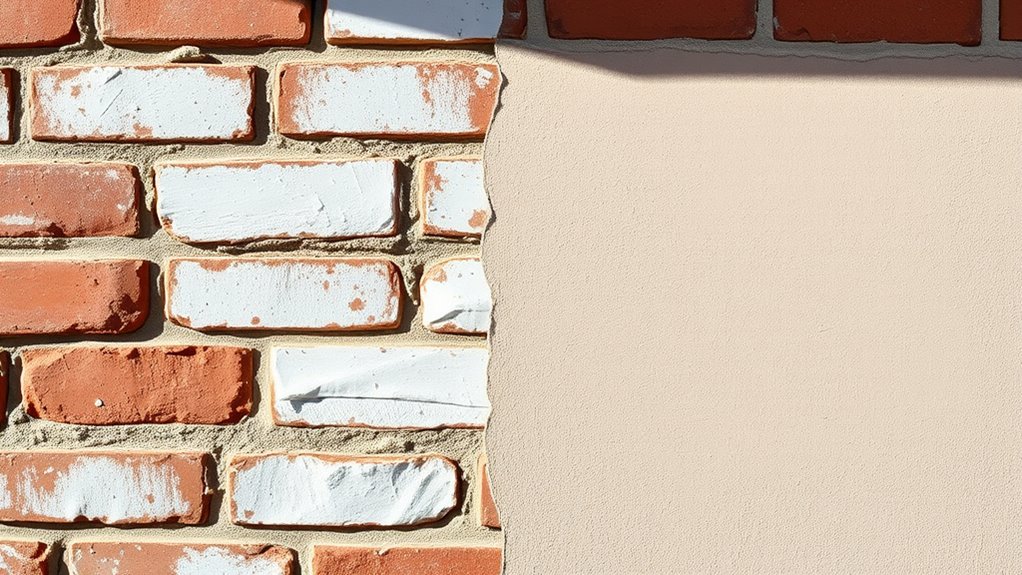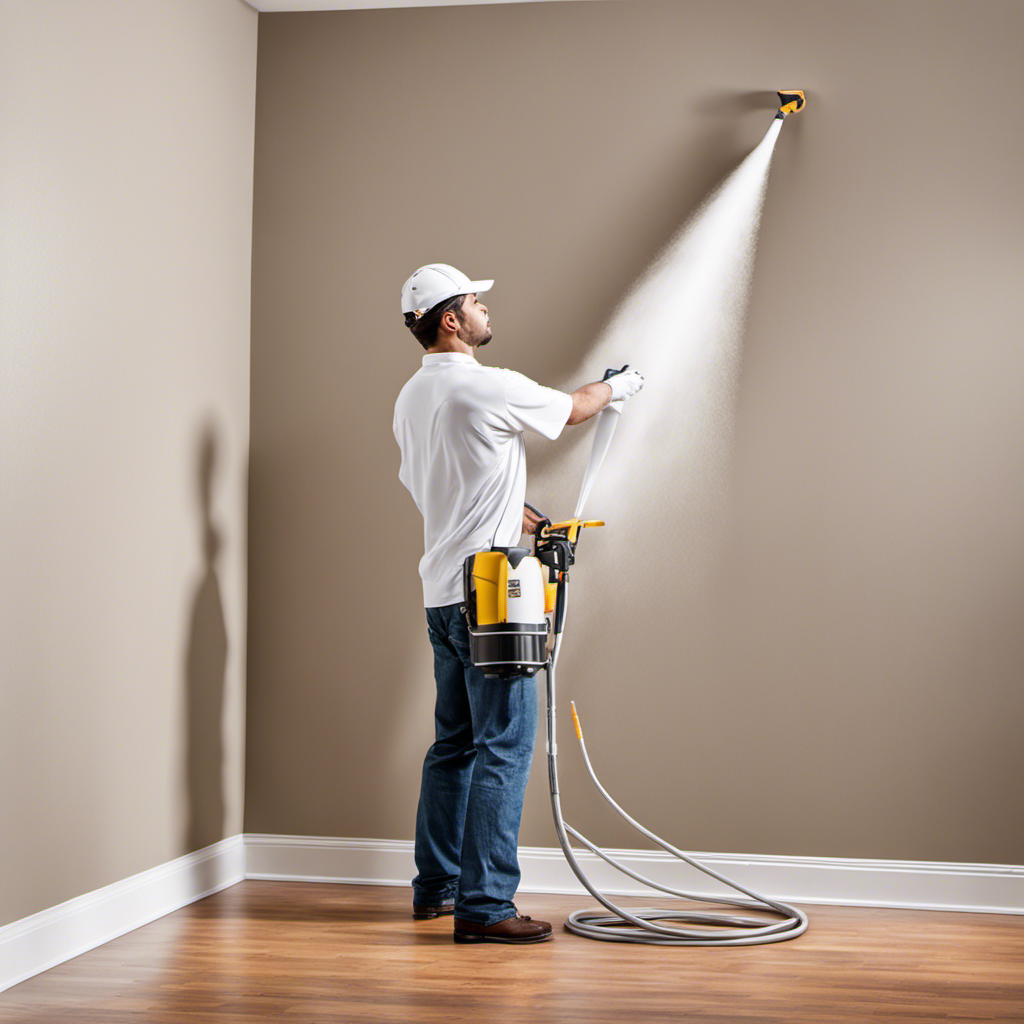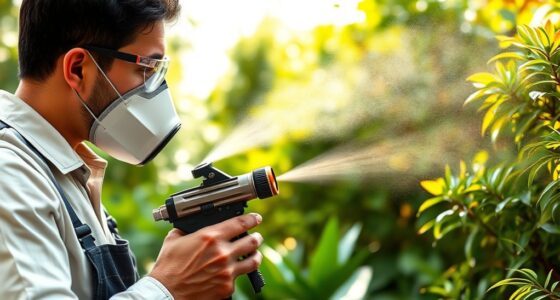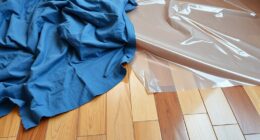When choosing between elastomeric and acrylic paint for spraying exterior brick, consider your needs for flexibility, durability, and appearance. Elastomeric coatings offer excellent waterproofing and can stretch with surface movement, reducing cracking. Acrylics are more flexible, breathable, and provide a wider color range, but might need more frequent upkeep. Proper surface prep is vital for both, and your choice depends on whether you prioritize long-lasting waterproof protection or vibrant colors. Keep exploring to find the best fit.
Key Takeaways
- Elastomeric paint offers high elasticity, effectively accommodating brick movement and preventing cracks when sprayed.
- Acrylic paint provides a broader color selection and breathability, making it suitable for aesthetically varied exterior brick surfaces.
- Proper surface preparation, including cleaning and priming, is essential for both paints to ensure adhesion and durability.
- Spraying elastomeric coatings requires a clean, dry, primed surface for optimal application and performance.
- Long-term, elastomeric coatings tend to be more durable and waterproof, while acrylics may need more frequent touch-ups.
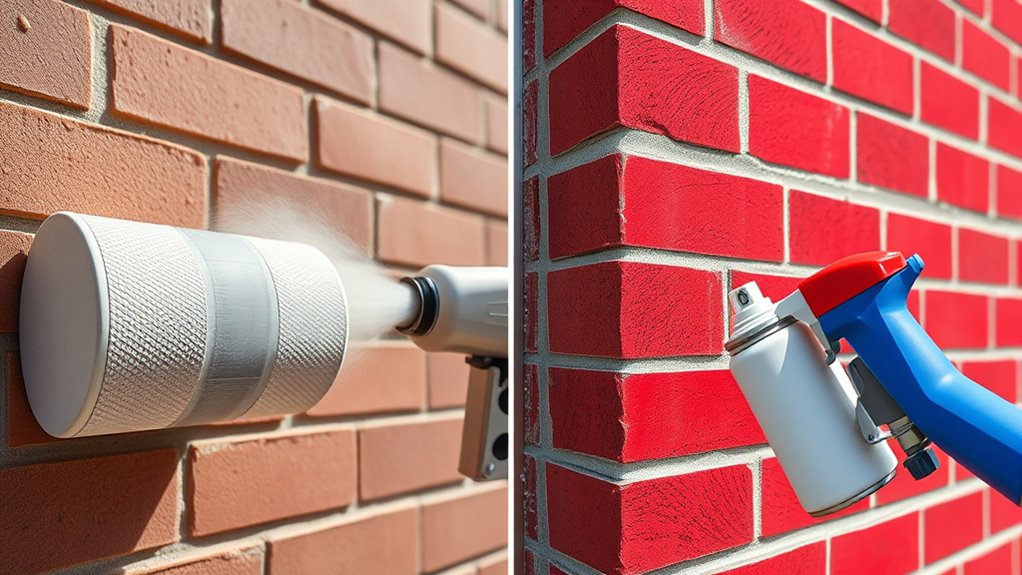
When choosing a coating for exterior brick surfaces, understanding the differences between elastomeric and acrylic paints is essential. Your decision impacts durability, appearance, and long-term maintenance. Before you even consider applying either type, focus on proper surface preparation. Clean the brick thoroughly, removing dirt, efflorescence, and any loose or peeling paint. A smooth, clean surface helps the coating adhere better and last longer. If necessary, repair damaged mortar or cracks to create a uniform base. Once the surface is prepped, you’ll need to decide on color selection. Bright, bold colors can refresh the look of your brick, while neutral shades offer a timeless appeal. Keep in mind that some paints may change appearance over time, especially in harsh weather, so choose colors that can withstand the elements and fading.
Elastomeric paints are known for their high elasticity, making them excellent for surfaces prone to movement or minor cracking. They stretch and contract with temperature changes, preventing cracks from forming or worsening. Their thick, rubber-like consistency provides a seamless, waterproof barrier that can protect your brick from moisture intrusion. When selecting elastomeric paint, consider color options carefully, as they tend to be limited compared to acrylics. Additionally, because elastomeric coatings are thicker, surface preparation is critical—any dirt or loose material can cause peeling or an uneven finish. Applying elastomeric paint over a clean, dry, and properly primed surface ensures ideal adhesion and durability.
Acrylic paints, on the other hand, are more flexible and breathable, allowing moisture within the brick to escape. They typically come in a wider range of colors, giving you more freedom to match or update your exterior aesthetic. Acrylics are easier to work with, dry faster, and are less likely to crack over time. For surface preparation, you still need to ensure the brick is clean and free of debris. A good primer can improve adhesion and ensure the color stays vibrant longer. Keep in mind that acrylic paints might require more frequent touch-ups or repainting over the years, especially if exposed to intense sunlight or moisture.
Ultimately, your choice hinges on your specific needs—if you want a highly flexible, waterproof coating that can handle surface movement, elastomeric might be best. If you prefer a broader color palette and easier application, acrylics could be more suitable. Regardless of your choice, thorough surface preparation and careful color selection are key to achieving a long-lasting, attractive finish on your exterior brick.
Frequently Asked Questions
How Long Does Each Coating Typically Last Before Repainting?
Elastomeric coatings usually last 15-20 years before needing a repaint, thanks to their durability comparison and flexibility. Acrylic coatings typically last 5-10 years, requiring more frequent maintenance. You should consider elastomeric if you want a longer-lasting protective layer with less upkeep, while acrylics are suitable if you prefer easier, quicker maintenance. Your choice depends on how much durability and maintenance you prioritize for your exterior brick.
Can Both Elastomeric and Acrylic Paints Be Applied in Cold Weather?
You can apply both elastomeric and acrylic paints in cold weather, but you need to take temperature considerations carefully. Be aware that low temperatures can affect adhesion and drying times. To ensure proper application techniques, work during the warmest part of the day and avoid applying paint when frost or freezing conditions are imminent. Proper preparation and following manufacturer guidelines will help you achieve a durable, lasting finish even in cooler temperatures.
Are There Environmental Benefits Associated With Each Type of Coating?
You’ll find that elastomeric paints often have a lower environmental impact because they last longer, reducing the need for frequent reapplication and waste. Acrylic paints tend to be more sustainable due to their water-based formulation, which emits fewer VOCs and is easier to clean up. Both coatings offer sustainability benefits by protecting your brick with minimal environmental harm, but choosing the right one depends on your specific needs and environmental priorities.
Which Coating Is Better for Historic Brick Preservation?
You should choose acrylic paint for historic brick preservation, as it’s gentle yet durable enough to protect delicate surfaces without causing damage. Imagine safeguarding a priceless masterpiece—acrylic maintains the brick’s historic character while offering excellent paint durability. Elastomeric coatings, though tough, can trap moisture and compromise the brick’s integrity over time. For preservation, acrylic’s flexibility and breathability make it the better choice, ensuring your historic brick remains beautiful for generations.
How Do These Paints Affect the Breathability of Brick Surfaces?
Elastomeric paints reduce moisture vapor transmission, markedly impacting breathability by sealing the brick surface tightly. Acrylic paints allow more moisture vapor to escape, maintaining better breathability. If you want to preserve the brick’s natural moisture exchange, acrylics are preferable. Elastomeric coatings might trap moisture, leading to potential damage over time. Consider your climate and brick condition when choosing, ensuring you don’t compromise the brick’s ability to breathe.
Conclusion
Choosing between elastomeric and acrylic coatings for your exterior brick is essential—think of it as the difference between a superhero shield and a gentle rain. Elastomeric offers unmatched durability, standing strong against the fiercest weather storms, while acrylic provides flexibility and vibrant color. Ultimately, your decision impacts your home’s protection and curb appeal for years to come. Pick wisely, because your brick’s future depends on a coating that can outlast even the mightiest forces of nature.
Franz came aboard the Paint Sprayer Zone team with a background in both journalism and home renovation. His articulate writing style, combined with a passion for DIY projects, makes him an invaluable asset. Franz has a knack for breaking down technical jargon into easy-to-understand content, ensuring that even the most novice of readers can grasp the complexities of paint sprayers.
